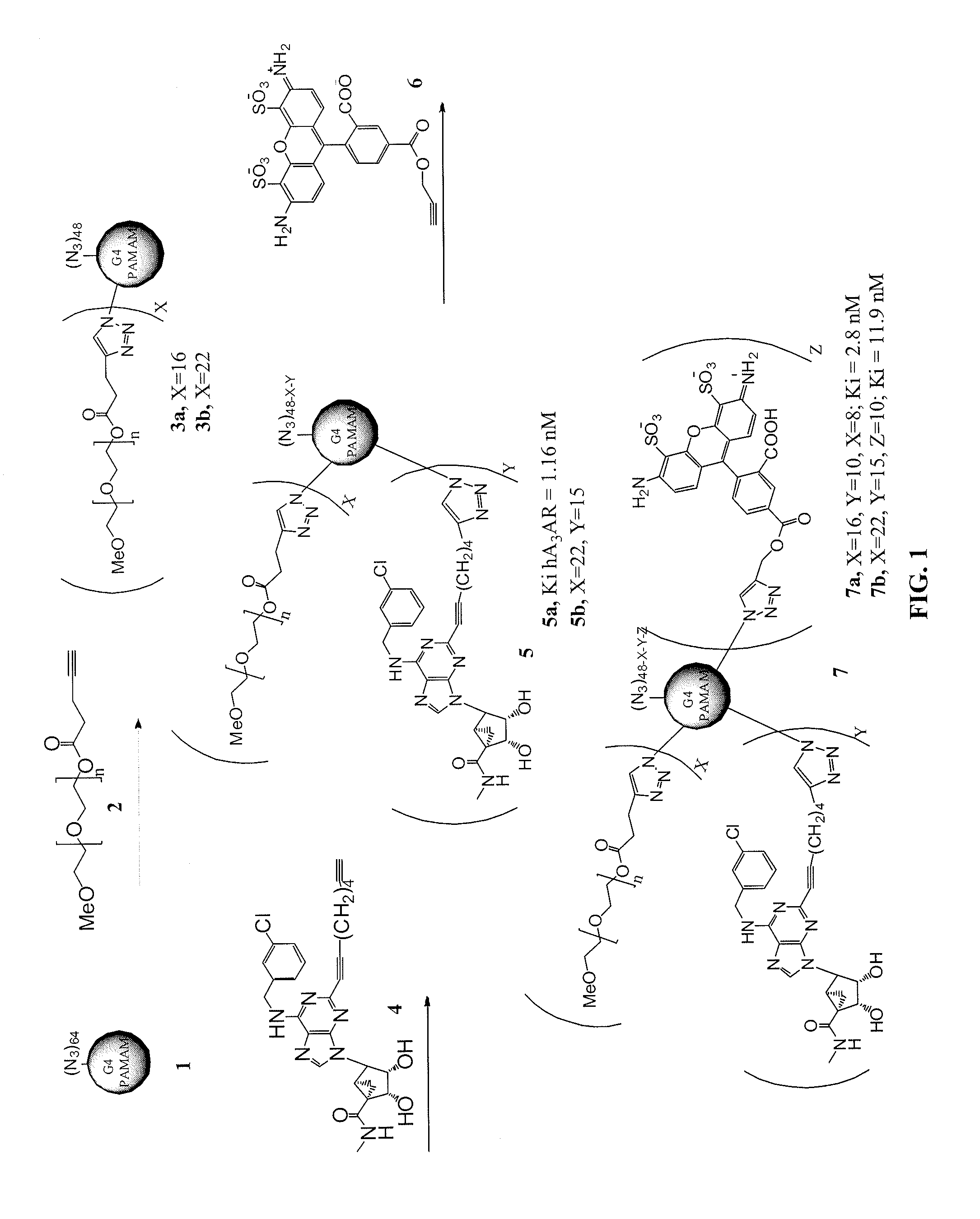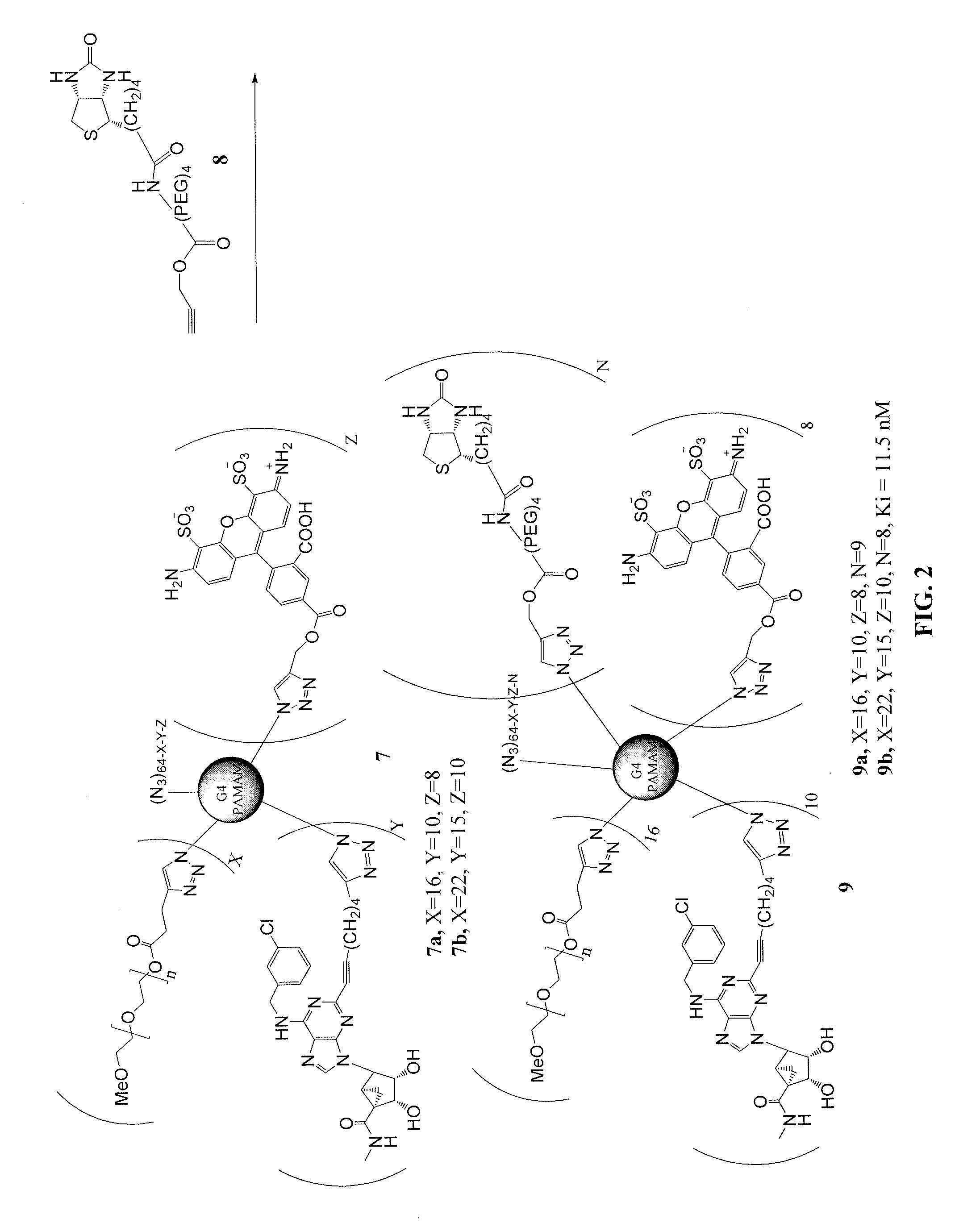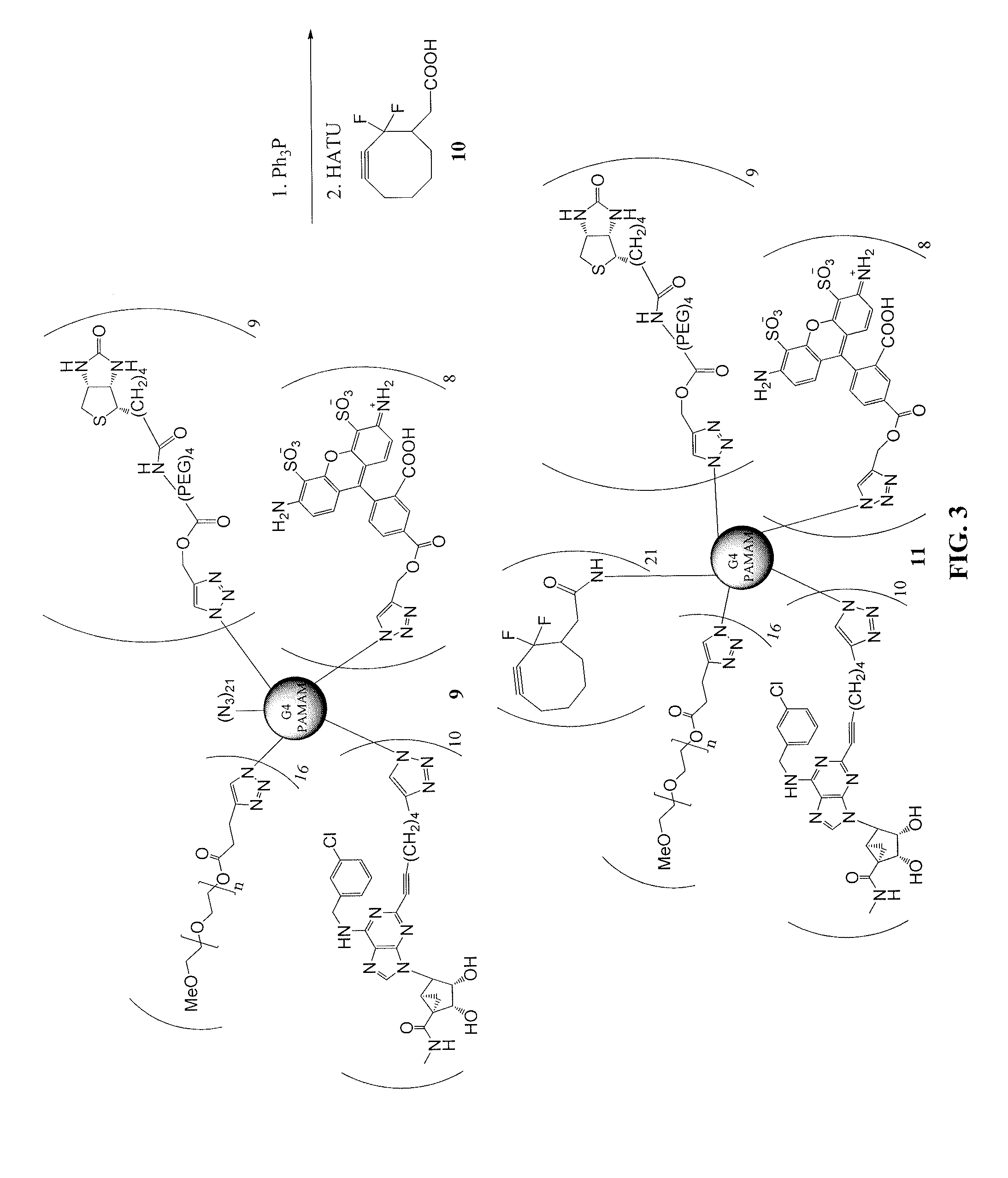Methanocarba adenosine derivatives, pharmaceutical compositions, and method of reducing intraocular pressure
a technology of adenosine derivatives and adenosine derivatives, applied in the direction of drug compositions, biocide, cardiovascular disorders, etc., can solve the problems of limited therapeutic application potential utility of a/sub>1/sub>and a/sub>2/sub>-selective agents
- Summary
- Abstract
- Description
- Claims
- Application Information
AI Technical Summary
Benefits of technology
Problems solved by technology
Method used
Image
Examples
example 1
[0315]This example illustrates the synthesis of compounds in accordance with an embodiment of the invention. See FIGS. 8-10 for reaction schemes illustrating the synthesis.
(1′S, 2′R, 3′S, 4′S, 5′S)-4′-[6-(3-Chlorobenzylamino)-2-(1,6-heptadiynyl)-9H-purin-9-yl]-(1′S, 2′R, 3′S, 4′S, 5′S)-4′-[6-(3-Chlorobenzylamino)-2-(1,7-octadiynyl)-9H-purin-9-yl]-2′,3′-O-isopropylidenebicyclo[3.1.0]hexane-1′-carboxylic acid N-methylamide (7)
[0316]To a solution of compound 5 (440 mg, 0.73 mmol) in anhydrous DMF (12 mL), Pd(PPh3)4 (92 mg, 0.08 mmol), CuI (30.5 mg, 0.16 mmol), 1,7-octadiyne (1.0 mL, 8.01 mmol) and then triethylamine (0.22 mL, 1.6 mmol) was added. The reaction mixture was heated at 60° C. for overnight. Solvent was evaporated under vacuum and the residue was purified on flash silica gel column chromatography (CH2Cl2:MeOH=70:1) to give the compound 7 (352 mg, 83%) as a foamy syrup. 1H NMR (CD3OD, 300 MHz) δ 8.11 (s, 1H), 7.43 (s, 1H), 7.26-7.33 (m, 3H), 5.74 (d, J=7.2 Hz, 1H), 5.01 (s, 1...
example 2
[0340]This example illustrates some of the properties of the compounds in accordance within an embodiment of the invention.
[0341]Receptor Binding and Functional Assays
[0342][3H]Adenosine-5′-N-methyluronamide (36, [3H]NECA, 42.6 Ci / mmol) was obtained from Perkin Elmer. [3H](2-[p-(2-Carboxyethyl)phenyl-ethylamino]-5′-N-ethylcarboxamido-adenosine) (37, [3H]CGS21680, 40.5 Ci / mmol) and [125I]N6-(4-amino-3-iodobenzyl)adenosine-5′-N-methyluronamide (38, [125I]I-AB-MECA, 2200 Ci / mmol) were purchased from Perkin-Elmer Life and Analytical Science (Boston, Mass.). Test compounds were prepared as 5 mM stock solutions in DMSO and stored frozen at −20° C.
[0343]Cell Culture and Membrane Preparation:
[0344]CHO cells stably expressing the recombinant hA1 and hA3Rs, and HEK-293 cells stably expressing the hA2AAR were cultured in Dulbecco's modified Eagle medium (DMEM) and F12 (1:1) supplemented with 10% fetal bovine serum, 100 units / mL penicillin, 100 μg / mL streptomycin, and 2 mmol / mL glutamine. In ad...
example 3
[0351]This example illustrates a method of preparing dendrimer conjugates in accordance with another embodiment of the invention. See FIGS. 11-14.
G4 PAMAM, Conjugated with 6-heptynoic acid (115)
[0352]Freshly prepared aqueous sodium ascorbate (1 M, 42 μL, 42.1 μmmol) was added to a mixture of G4 PAMAM dendrimer 113 (6.74 mg, 0.42 μmol) and 6-heptynoic acid (1.33 mg, 10.5 μmol) in a mixture of t-butanol (0.3 mL) and water (0.3 mL), then 7.5% aqueous cupric sulfate (70 μL, 20.8 μmmol) was added. The reaction mixture was stirred at room temperature overnight, and the product was purified by dialysis in water. The mixture was lyophilized to yield compound 115 (5.45 mg, 68%) as a white foamy solid. MALDI-MS: calcd. 19,029. Found 18,928.
G4 PAMAM, Conjugated with A3AR Agonist 103a and 6-heptynoic Acid (107)
[0353]Freshly prepared aqueous sodium ascorbate (1 M, 31 μL, 31 μmmol) was added to a mixture of compound 115 (5.45 mg, 0.28 μmol) and compound 103a (4.13 mg, 7.74 mol) in a mixture of t-...
PUM
| Property | Measurement | Unit |
|---|---|---|
| flow rate | aaaaa | aaaaa |
| pH | aaaaa | aaaaa |
| temperature | aaaaa | aaaaa |
Abstract
Description
Claims
Application Information
 Login to View More
Login to View More - R&D
- Intellectual Property
- Life Sciences
- Materials
- Tech Scout
- Unparalleled Data Quality
- Higher Quality Content
- 60% Fewer Hallucinations
Browse by: Latest US Patents, China's latest patents, Technical Efficacy Thesaurus, Application Domain, Technology Topic, Popular Technical Reports.
© 2025 PatSnap. All rights reserved.Legal|Privacy policy|Modern Slavery Act Transparency Statement|Sitemap|About US| Contact US: help@patsnap.com



